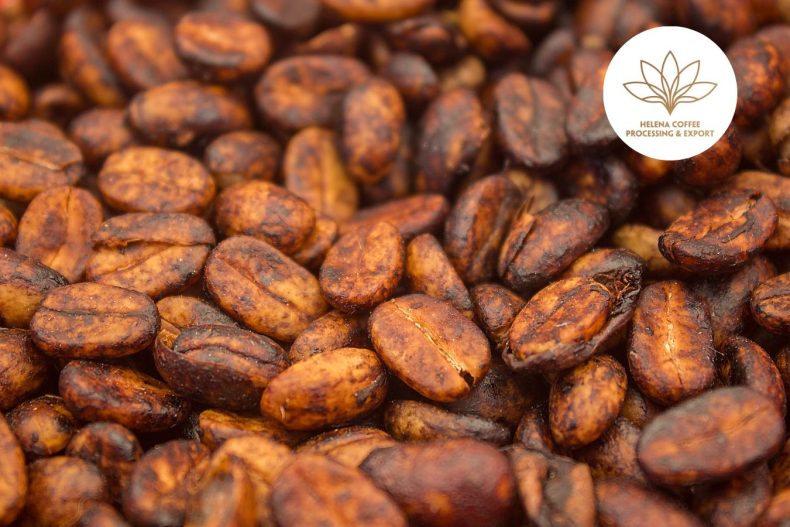
What Causes The Acidity Of Coffee? When acidity is mentioned in the taste of coffee, it’s often misunderstood. It’s as if you were biting into a slice of lemon with a sour, sharp, sharp, and relatively unpleasant sensation. But in the context of coffee, ” acidity ” is often a desirable characteristic. With a well-balanced coffee, the acidity feels like you’re biting into an apple.
So, let’s learn together with Helena Coffee Vietnam about what causes the acidity of coffee originates.
Coffee Acidity properties
Many factors affect the acidity of coffee, including seed source, farming method, processing, roasting technique, etc. Coffee grown at high altitudes or in mineral-rich soils is often more acidic.
Furthermore, wet-processed coffee is often more scathing than naturally dry-processed coffee – on the one hand, because wet fermentation promotes the production of certain organic acids. On the other hand, Dry-processed coffee often adds more flavor to the cup, making sense of acidity significantly overpowering.

Regardless of the acidity, coffee usually scores only five on the pH scale. Purified water is 7, saliva is 6, and orange juice is 3. However, there is evidence that the chlorogenic acid in coffee increases acid levels in the stomachs of coffee drinkers, which can trigger Acid reflux – Roast magazine.
Although acidity is an essential criterion of the Cupping technique – i.e., tasting coffee. However, in the Vietnamese people’s coffee enjoyment habits, the impact of acid in coffee is not the desired or necessary taste, the way of dark roasting, and the quality of Robusta coffee beans with many defects in the stages.
Processing has limited the enjoyment of Vietnamese coffee’s “perfect acidity.” On the other hand, some coffees are appreciated globally with typical acidities such as Kenya AA, Ethiopia Yirgacheffe, Costa Rica, and Nicaragua…
Some common acids in coffee beans
Although most of the organic acids in coffee acidity have been studied, science cannot yet answer how the different acids interact to create coffee flavor. But suffice it to say that not all acids taste great (some acid radicals are very bitter).
Therefore, acidity is the combination and balance of different acids and other flavor compounds that provide a pleasant organoleptic character in coffee. In general, acidity is the counterbalance to sweetness ( sweetness ) that helps a cup of coffee not become bland. Here are some of the most critical acids found in coffee:
Chlorogenic Acid in Coffees
In 1932, Chlorogenic acids represented a large family of ester compounds and acids in green and roasted coffee. To date, chlorogenic acid is still one of the most common acids in coffee, with 5.5 -8% in Arabica and 7 – 10% in Robusta. Along with Caffeine, CGA has a role in helping coffee fight pests and diseases, so in nature, Robusta coffee has a better growth ability when it contains nearly twice the content of CGA and Caffeine compared to Arabica.

In addition to being common in coffee with more than ten different structural isomers, CGA is also known for its role as a natural antioxidant in coffee with much higher concentrations than green tea, from 200 to 550mg in about 175ml.
Characteristics of the CGA are sensitive to temperature, so during roasting, CGA will decompose slowly – about 50% to form caffeic acid and acid quinic causing a bitter taste significantly in coffee.
Citric Acid – Orange, Lemon
It is the second most abundant organic acid in coffee. Citric acid is produced by the coffee plants themselves, not by roasting. The citric acid in coffee is the same as in citrus fruits. As you might have guessed, it has something to do with citrus flavors, even grapefruit.
When roasting, citric acid reaches its maximum during light roasting and rapidly declines as roast intensity increases. A grain roasted medium typically takes about 50% of the initial concentration of citric acid.

The farmer plays a significant role in the effect of citric acid in the cup. Citric acid is converted to sugar during ripening, with unripe coffee beans having a higher citric acid content. Great coffees come from batches that have been carefully harvested and screened to ensure all beans come from perfectly ripe cherries.
From green to roasted, citric acid measured from 13.11g/kg, down to 6.34g/kg.
Acetic Acid – Vinegar
Acetic acid, commonly known as vinegar, is one of many organic acids that play an essential role in the quality of coffee. The concentration of acetic acid is high or low depending on the wet or dry processing method, so this is the acid produced significantly during processing, not much in the coffee itself.
When fermentation occurs with sweet fruits such as grapes or coffee, natural yeasts usually carry out fermentation. They consume sugar and convert it to alcohol. The alcohol is then converted to acetic acid by acetic acid-producing bacteria.
Depending on the time and temperature during fermentation environmental factors and the nature of the coffee beans, the final concentration of acetic acid will vary.

During roasting, the concentration of acetic acid increases dramatically. During this stage, the carbohydrates in coffee such as sucrose begin to decompose, leading to fatty acids such as acetic, formic, etc.
Depending on the actual conditions when roasting, the concentration of acetic acid can increase up to 25 times compared to that of coffee beans. With the original content in green coffee. The overall Acetic acid concentration peaks at Light – Medium roasts and then rapidly degrades in dark roasts due to its volatile nature.
